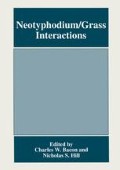Abstract
Many endophytic fungi are asymptomatic, showing no external signs of infection. The majority, however, produce alkaloids (West, 1994). Alkaloids are the proposed toxic agents to vertebrate herbivores (Lyons et al., 1986; Read and Camp. 1986) and are also attributed to reducing insect herbivory (Siegel et a/., 1990; Breen, 1994)
Access this chapter
Tax calculation will be finalised at checkout
Purchases are for personal use only
References
Belesky, D.P., J.D. Robbins. J.A. Stuedemann, S.R. Wilkinson, and O.J. Devine. 1987. Fungal endophyte infection loline derivative alkaloid concentration of grazed tall fescue. Agro. J. 79: 217–220.
Breen, J. 8. 1994. 4 Acremonium endophyte interactions with enhanced plant resistance to insects. Ann. Rev. Entomol. 39: 401–423.
Bultman, T.L., and D.T. Ganey. 1995. Induced resistance to Fall army worm ( Lepidoptera: Noctuidae) mediated by a fungal endophyte. Environ. Entomol. 24: 1196–1200
Cheplick, G.R. and K. Clay 1988. Acquired chemical defenses in grasses: the role of fungal endophytes. Oikos. 52: 309–318.
Eichenseer, H. D.L. Dahlman. and L.P. Bush. 991. Influence of endophyte infection, plant age and harvest on Rhopalosiphum padi survival and its relation to the quantity; of N-formyl and N-N-acetyl loline in tall fescue. Entomol. Exper. Appl. 60: 29–38.
Hardy, T.N., K. Clay and A.M. Hammond. 1986. Leaf age and related factors affecting endophyte-mediated resistance to Fall army worm(Lepidoptera: Noctuidae) in Tall Fescue. Environ Entomo. 15: 1083–1089.
Lyons, C., RD. Plattner, and C.W. Bacon. 1986. Occurrence of peptide and clavine ergot alkaloids in tall fescue grass. Science, 232: 487–489.
Read, J.C., and B.J. Camp. 1986. The effect of the fungal endophyte Acremonium coenophialum in tall fescue on animal performance toxicity and stand maintenance. Agro J. 78: 848–850.
Siegel, M.R., G.C.M. Latch, L.P. Bush, F.F. Fannin. D.D. Rowan, B.A. Tapper. C.W. Bacon. and M.C. Johnson. 1990. Fungal endophyte-infected grasses: alkaloid accumulation and aphid response. J Chem Ecol. 16: 3301–33 15.
West, C.P. 1994. Physiology, and drought tolerance of endophyte-infected grasses. pp. 87–99. In: Bacon, C.W., and J.F. White (eds.). Biotechnology of endophytic fungi of grasses. CRC Press. Inc., Boca Raton, Fla.
Author information
Authors and Affiliations
Editor information
Editors and Affiliations
Rights and permissions
Copyright information
© 1997 Springer Science+Business Media New York
About this chapter
Cite this chapter
Murphy, J.C., Bultman, T.L. (1997). Effects of Natural and Artificial Herbivory on Endophyte-Infected Tall Fescue, Festuca Arundinacea and Response by the Aphid, Rhopalosiphum Padi . In: Bacon, C.W., Hill, N.S. (eds) Neotyphodium/Grass Interactions. Springer, Boston, MA. https://doi.org/10.1007/978-1-4899-0271-9_33
Download citation
DOI: https://doi.org/10.1007/978-1-4899-0271-9_33
Publisher Name: Springer, Boston, MA
Print ISBN: 978-1-4899-0273-3
Online ISBN: 978-1-4899-0271-9
eBook Packages: Springer Book Archive

